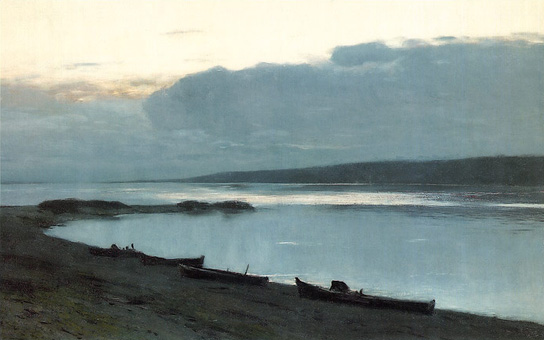The following interview appeared in the Summer 2008 issue of the California Art Club Newsletter and is published here in its entirety with the permission of the California Art Club, californiaartclub.org.The Artist As Critic: Art That InspiresAn Interview with Joseph Paquet  Isaak Levitan (1860 – 1900), Evening on the Volga, Oil on linen 19.5 x 31.6, Collection of Tretyakov Gallery, Moskow, Russia Miriam Nöske (MN): Why did you choose “Evening on the Volga” by Isaak Levitan? Joseph Paquet (JP): When I was a young man I visited an exhibition on Russian painting and iconography at the Smithsonian Arthur M. Sackler Gallery in Washington, D.C., and saw Evening on the Volga by Isaak Levitan. I was immediately struck by its power and lack of forced drama; in fact it was quite the opposite. Levitan depicted nature in an exquisite tonality with a poetic sensibility what he saw, translating nature’s beauty in a pure and authentic way effectively getting my attention with a whisper.
MN: What interests you most about this early painting in regards to composition and techniques? JP: Evening on the Volga is a quiet painting with exquisite tonality and genre colour, yet boldly painted. Strong opposing diagonals create power and pull the eye into the picture. The balance is perfect.
MN: Comparing the painting by Isaak Levitan to your painting, Pepsi & Pilings, what similarities or influences do you find in your own artwork? JP: Pepsi & Pilings was painted on the Brooklyn side of the East River in New York. I like the combination of “Then and Now” with the old advertising board in an industrial landscape – a landscape in a state of flux. I have orchestrated the colors, tones and shapes in a rhythmic sense. This continuous sense of movement presents the momentary experience of that calm day on the river.
MN: How inspirational is Levitan’s artwork in terms of subject matter and American context for you? JP: Levitan is not a romantic painter; his work translates pure authenticity. I like the autobiographical aspect of his art. The river Volga is part of his homeland and Evening on the Volga is his homeland epic. He presented the universal in the particular. I personally seek things which may be outwardly unremarkable and unpretentious – things that are simply genuine.
MN: What do you like about working directly from nature and painting en plein air? JP: Painting en plein air is a sensory experience which offers an intensity of encounter. You engage all senses when you paint outdoors. The painting is informed by the sound of the street or wave, the smell of the eucalyptus or the fine breeze. The beauty of nature becomes a memorable sensory event which enhances ones imagination while creating a painting.
MN: Art is a combination of seeing and thinking – knowing and seeing. How do you work in terms of skilled techniques and intuition? JP: I take more time walking in and around areas that interest me. I pay close
MN: Do you work on several preliminary drawings or oil sketches before translating them into larger works? JP: I work from life and create oil sketches and field studies which I later translate to larger canvases.
MN: What literary resources or research do you use for developing your art? JP: I highly recommend reading the book, Beauty – The Invisible Embrace, by John O’Donohue. It is a fascinating essay about exposing the infinity and mystery of beauty’s presence and perception. Another literary resource for me is Rainer Maria Rilke’s Letters to a Young Poet because it talks about genuine motifs to create.
MN: How would you describe briefly what art means to you? JP: I am never in a great hurry to find individuality. As an artist you have to be internally motivated and be clear about technical skills and intent. Artistically speaking, life is like a tightening spiral – gradually becoming clearer as one continuously winds around, finally centering on what is most important and fascinating.
Notes: Return to Press Page |


